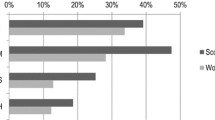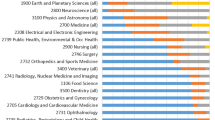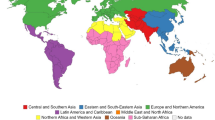Abstract
The study compares the coverage, ranking, impact and subject categorization of Library and Information Science journals, specifically, 79 titles based on data from Web of Science (WoS) and 128 titles from Scopus. Comparisons were made based on prestige factor scores reported in 2010 Journal Citation Reports and SCImago Journal Rank 2010 and noting the change in ranking when the differences are calculated. The rank normalized impact factor and the Library of Congress Classification System were used to compare impact rankings and subject categorization. There was high degree of similarity in rank normalized impact factor of titles in both WoS and Scopus databases. The searches found 162 journals, with 45 journals appearing in both databases. The rankings obtained for normalized impact scores confirm higher impact scores for titles covered in Scopus because of its larger coverage of titles. There was mismatch of subject categorization among 34 journal titles in both databases and 22 of the titles were not classified under Z subject headings in the Library of Congress catalogue. The results revealed the changes in journal title rankings when normalized, and the categorization of some journal titles in these databases might be incorrect.

Similar content being viewed by others
References
Amin, M., and Mabe, M. (2000). Impact factors: use and abuse. Perspectives in Publishing, 1, 1–6. Retrieved 28 Sept 2011. http://www.elsevier.com/framework_editors/pdfs/Perspectives1.pdf.
Bergstrom, C. T. (2007). Eigenfactor: measuring the value and prestige of scholarly journals. College and Research Libraries News, 68(5), 314–316.
Chung, H. K. (2007). Evaluating academic journals using impact factor and local citation score. Journal of Academic Librarianship, 33(3), 393–402.
Della Sala, S., & Grafman, J. (2009). Five-year impact factor. Cortex, 45(8), 911.
Dombrowski, T. (1988). Journal evaluation using Journal Citation Reports as a collection tool. Collection management, 10(3/4), 175–180.
Egghe, L. (2006). Theory and practice of the g-index. Scientometrics, 69, 131–152.
Frandsen, T., Rousseau, R., & Rowland, I. (2006). Diffusion factors. Journal of Documentation, 62(1), 58–72.
García, J. A., Rodriguez-Sánchez, R., & Fdez-Valdivia, J. (2011). Ranking of the subject area of Scopus. Journal of the American Society for Information Science and Technology, 62(10), 2013–2023. doi:10.1002/asi.21589.
Garfield, E. (1999). Journal impact factor: a brief review. Canadian Medical Association Journal, 161, 1–7.
Garfield, E. (2005). The agony and the ecstasy: the history and meaning of the journal impact factor. International Congress on Peer Review and Biomedical Publication. Retrieved 30 Aug 2011. http://garfield.library.upenn.edu/papers/jifchicago2005.pdf.
Gavel, Y., & Iselib, L. (2008). Web of Science and Scopus: a journal title overlap study. Online Information Review, 32(1), 8–21.
Gómez-Núñez, A. J., Vargas-Quesada, B., de Moya-Anegón, F., & Glanzel, W. (2011). Improving SCImago Journal and Country Rank (SJR) subject classification through reference analysis. Scientometrics, 89, 741–758. doi:10.1007/s11192-011-0485-8.
Gonzalez-Pereira, B., Guerrero-Bote, V. P., & Moya-Anegon, F. (2010). A new approach to the metric of journal scientific prestige: the SJR indicator. Journal of Informetrics, 4(3), 379–391.
Haddow, G., & Genoni, P. (2009). Australian education journals: quantitative and qualitative indicators. Australian Academic and Research Libraries, 40(2), 17.
Harzing, A.W. (2010). Working with ISI data: beware of categorization problems. Research in International Management (20 January). Online: http://www.harzing.com/isi-categorization.
Hirsch, J.E. (2005). An index to quantify an individal’s scientific research output, Proceedings of the National Academy of Sciences, USA, 102(46) 15 November, 16569–16572.
Katz, J. S., & Hicks, D. (1995). The classification of interdisciplinary journals: a new approach (pp. 105–115). Brighton: Social Policy Research Unit, University of Sussex.
Leydesdorff, L., Moya-Anegón, F., & Guerrero-Bote, V. P. (2010). Journal maps on the basis of Scopus data: a comparison with the Journal Citation Reports of the ISI. Journal of the American Society for Information Science and Technology, 61(2), 352–369.
Lopez-Illescas, C., Moya-Aregon, F., & Moed, H. F. (2008). Coverage and citation impact of oncological journals in the Web of Science and Scopus. Journal of Informetrics, 2(4), 304–316.
Meho, L. I., & Spurgin, K. M. (2005). Ranking the research productivity of LIS faculty and schools: an evaluation of data sources and research methods. Journal of the American Society for Information Science and Technology, 56(2), 1314–1331.
Meho, L. I., & Sugimoto, C. R. (2009). Assessing the scholarly impact of information studies: a tale of two citation databases—Scopus and Web of Science. Journal of the American Society for Information Science and Technology, 60(11), 2499–2508.
Moed, H. F. (2010). Measuring contextual citation impact of scientific journals. Journal of Informetrics, 4(3), 265–277.
Moya-Anegón, F., Chinchilla-Rodríguez, Z., Vargas-Quesada, B., Corera-Álvarez, E., Muñoz-Fernández, F. J., González-Molina, A., et al. (2007). Coverage analysis of Scopus: a journal metric approach. Scientometrics, 73(1), 53–78.
Ng, S. L., & Zainab, A. N. (2003). Availability and overlaps of quality computer science journal holdings in selected university libraries in Malaysia. Malaysian Journal of Library & Information Science, 8(1), 45–63.
Pudovkin AI & Garfield E. 2004. Rank-normalized Impact Factor: A way to compare journal performance across subject categories. Proceedings of the 67th Annual Meeting of the American Society for Information Science & Technology, 41, 507–515, Providence, RI. November 17, 2004.
Raj, R.G., & Zainab, A.N. (2012). Relative measure index: a metric to measure quality. Scientometrics. doi: 10.1007/s11192-012-0675-z.
Rowland, I. (2002). Journal diffusion factors: a new approach to measuring research influence. Aslib Proceedings, 54(2), 77–84.
Schloegl, C., & Stock, W. G. (2004). Impact and relevance of LIS journals: a scientometric analysis of international and German-language LIS journals—citation analysis versus reader survey. Journal of the American Society for Information Science and Technology, 55(13), 1155–1168. doi:10.1002/asi.20070.
Sombatsompop, N., & Markpin, T. (2005). Making an equality of ISI impact factors for different subject fields. Journal of the American Society for Information Science and Technology, 56(7), 676–683.
Tahal, A., & Meyer, M. J. (1999). A revealed preference study of management journals’ direct influences. Strategic Management Journal, 20(3), 279–296.
Tsay, M. Y. (1998). The relationship between journal use in a medical library and citation use. Bulletin of the Medical Library Association, 86(1), 31–39.
Wagner, A.B. (2009). Percentile-Based Journal Impact Factors: A Neglected Collection Development Metric. Issues in Science and Technology Librarianship. Spring 2009. Retrieved 17 Nov 2011. http://www.istl.org/09-spring/refereed1.html.
Acknowledgments
We acknowledge funding received from the Ministry of Higher Education Malaysia (HIR-MOHE) UM.C/HIR/MOHE/FCSIT/11, which made it possible to undertake this research.
Author information
Authors and Affiliations
Corresponding author
Rights and permissions
About this article
Cite this article
Abrizah, A., Zainab, A.N., Kiran, K. et al. LIS journals scientific impact and subject categorization: a comparison between Web of Science and Scopus. Scientometrics 94, 721–740 (2013). https://doi.org/10.1007/s11192-012-0813-7
Received:
Published:
Issue Date:
DOI: https://doi.org/10.1007/s11192-012-0813-7




